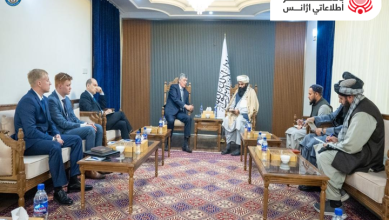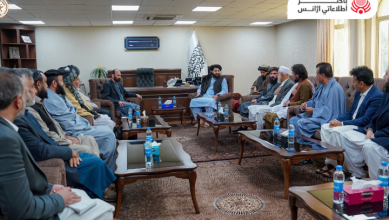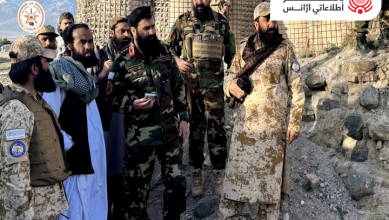
After shedding blood of thousands of civilians, politicians, policemen and soldiers, the Taliban has waged war against Afghan media.
The violent group has declared around 20 independent media organizations as party to the conflict and “mouthpiece of foreigners”.
The Taliban had not only issued a fatwa (religious verdict) and warnings to the free media outlets but has also prepared a media hit-list. Attacks on Pajhwok Afghan News’ bureau in Nangarhar and TOLO TV staffers marked the beginning of a declared war against free media.
In March 2016, the Taliban issued a warning statement to twenty media outlets. The militant group posted logos of the newspapers, radio and news channels that are on the hit-list. The statement is available on the Taliban’s website ((http://alemara1.org/?p=45152). Logos of the print and electronic media organizations—target of Taliban ire—were put together so the employees and managers of these organizations would know that they are on the hit-list.
TOLONews, TOLO TV, News One, Lamar, ATV, Shamshad, Saba, Outlook Afghanistan, Daily Afghanistan, Afghanistan Times, Salam Watandar, and Ariana News are among those media organizations that are in the Taliban crosshairs.
The lengthy warning message accuses these media organizations of siding with the NATO member states, “disbelievers”, particularly the United States and inciting people against Taliban.
“They [media outlets in the list] are serving the donors wholeheartedly. These foreign-funded media organizations are working against the national interests. They have no choice but consider it a responsibility. Some media and journalists who call themselves independent are deliberately acting as spokesmen for the invaders [NATO member states]. These media outlets and journalists never miss any opportunity to make propaganda against the mujahideen [holy worriers], despite Taliban have several times humbly requested them to take in account the journalistic principles,” the Taliban accused.
The militant group in its threat message said the independent media organizations are involved in propaganda against the Taliban aimed at putting the lid on the defeat of the United States and its NATO allies.
The Taliban said that such propaganda “brought death to the TOLO TV”. Warning the targeted media of series consequences for not doing what the group says, the Taliban said, “These media organizations must know that through such propaganda neither they can revenge nor cover the defeat of their lords [US and its allies] that they have suffered in the battle [against the Taliban] nor they can bring down morale of the mujahideen [Taliban fighters].”
To scare the journalists, the militant group gave attack on the TOLO TV staffers as a reference. On January 20, 2016, a Taliban suicide bomber targeted a mini-bus carrying employees of TOLO TV. At least seven staff members of the TOLO TV were killed and 26 others were injured. The militant group warned the TV channel and other media outlets in October 2015 of dire consequences. According to a report published by Afghanistan Times, almost 99 percent of Afghan media outlets are in the Taliban’s hit-list.
“The militant group’s so-called military commission has recently included all those print and electronic media organizations that have highlighted and condemned brutality of the Taliban through editorials, articles, news, feature and analytical reports. The group in a report on its website (www.shahamat-english.com) said: “There are very few in this media field who have actually fulfilled their true ethical duty, why? because most have only worked for the goals of the invaders.” The group warned to deal with the targeted media outlets in the same way as they are doing with foreign troops and Afghan forces,” the newspaper reported.
This has put the journalists and independent analysts in a difficult situation.
In November 2015, a prominent analyst and former diplomat, Ahmad Saeedi, was attacked close to the diplomatic oasis. He sustained bullet injuries, but luckily survived. However, the attack on him in Shahr-i-Naw area proves how difficult situation the journalists and analysts are facing. They are attacked in the heart of the capital city, Kabul. This was not the first incident.
Unidentified gunmen—yet to be traced by the security agencies—attacked Jaweed Kohistani’s house and Toofan Waziri. Both are well-known analysts.
This year in February, journalists were shot in Baghlan province. In like most of cases, here the attackers were also called ‘unknown’. Ibrahim, one of the injured journalists, sustained a gunshot wound to his head. He was unable to talk.
Seven staffers of the TOLO TV were killed in January this year when the Taliban dispatched a suicide bomber to target the TV channel. Driving an explosive-laden vehicle, the suicide bomber hit the minibus, carrying employees of the TOLO TV. The incident has shocked the journalists across the globe. It was not only attack on freedom of speech by a group known to all but also in a city where chiefs of all security agencies live including the commander-in-chief of the armed forces.
Not only news reporters and analysts are threatened but the terrorists have also warned the editors of prominent media outlets of serious consequences.
The editor-in-chief of Afghanistan Times, Abdul Saboor Sarir, was threatened several times. The 29-year old editor has received warning letters and calls from the militant groups. Taliban has several times dropped threat letters into his house.
According to report of the Planning and Operations Department of Police, the militants asked Mr. Sarir to change his newspaper’s policy towards them. In other words the insurgents wanted to use his paper as a propaganda channel.
It was not for the first time that he had contacted police. Before that he also told the police about warnings that he received. The newspaper has published several reports against different terrorist organizations including Daesh, Taliban and Haqqani Network. The militants call him a “staunch supporter” of the US and its western allies. He asked the relevant authorities to provide foolproof security to the media persons and organizations.
Nai, an organization supporting freedom of speech in Afghanistan, has termed January 2016 as one of the bloodiest months for local journalists and media organizations over the past sixteen years. According to Nai at least eight journalists were killed and over 20 others were injured in January.
There is no denying that journalists are working in a difficult situation. They are feeling insecure because they know that writ of the government is weak. Their families also live in fear. If the government failed to provide security, many journalists will lose their lives.




